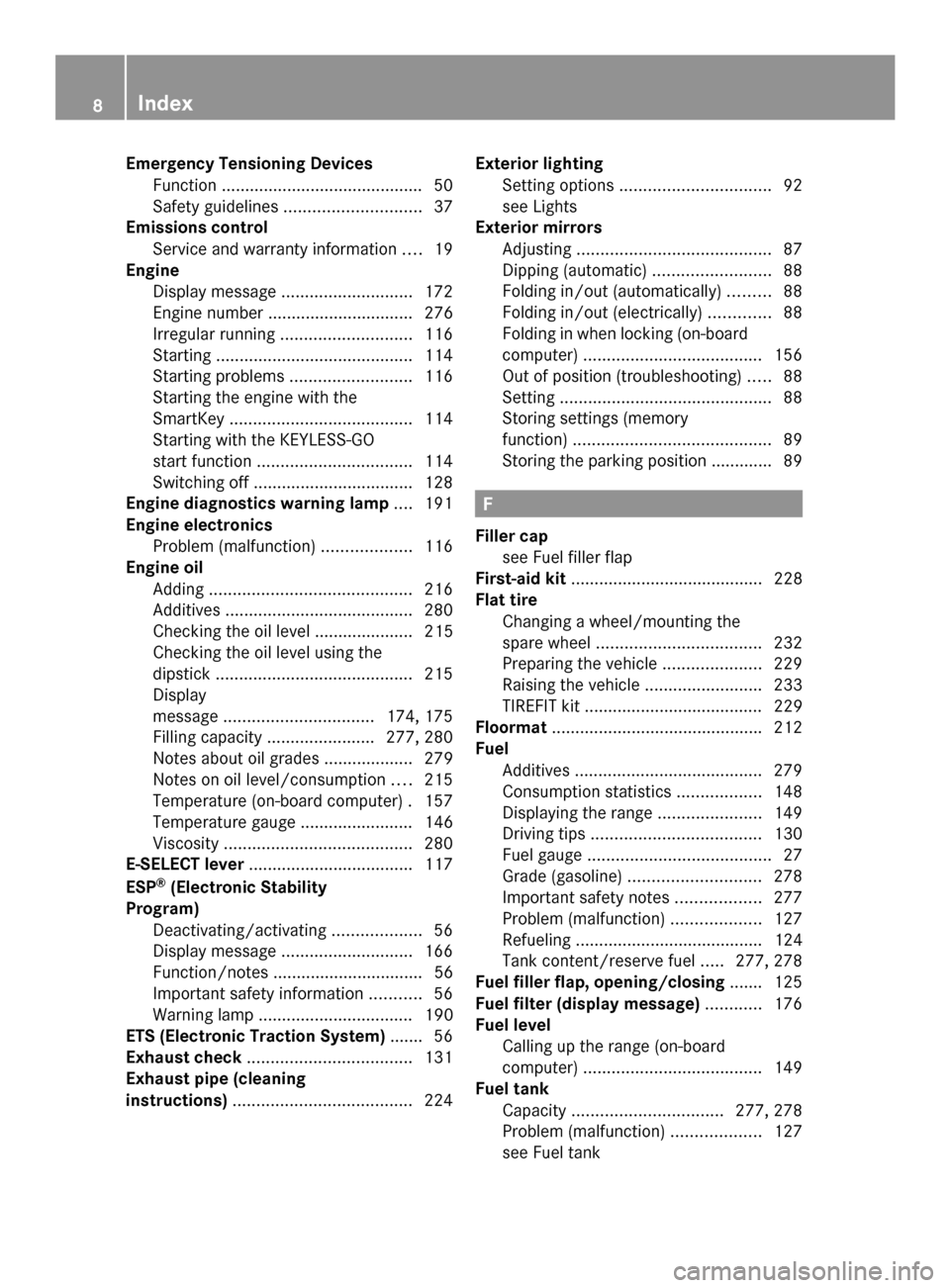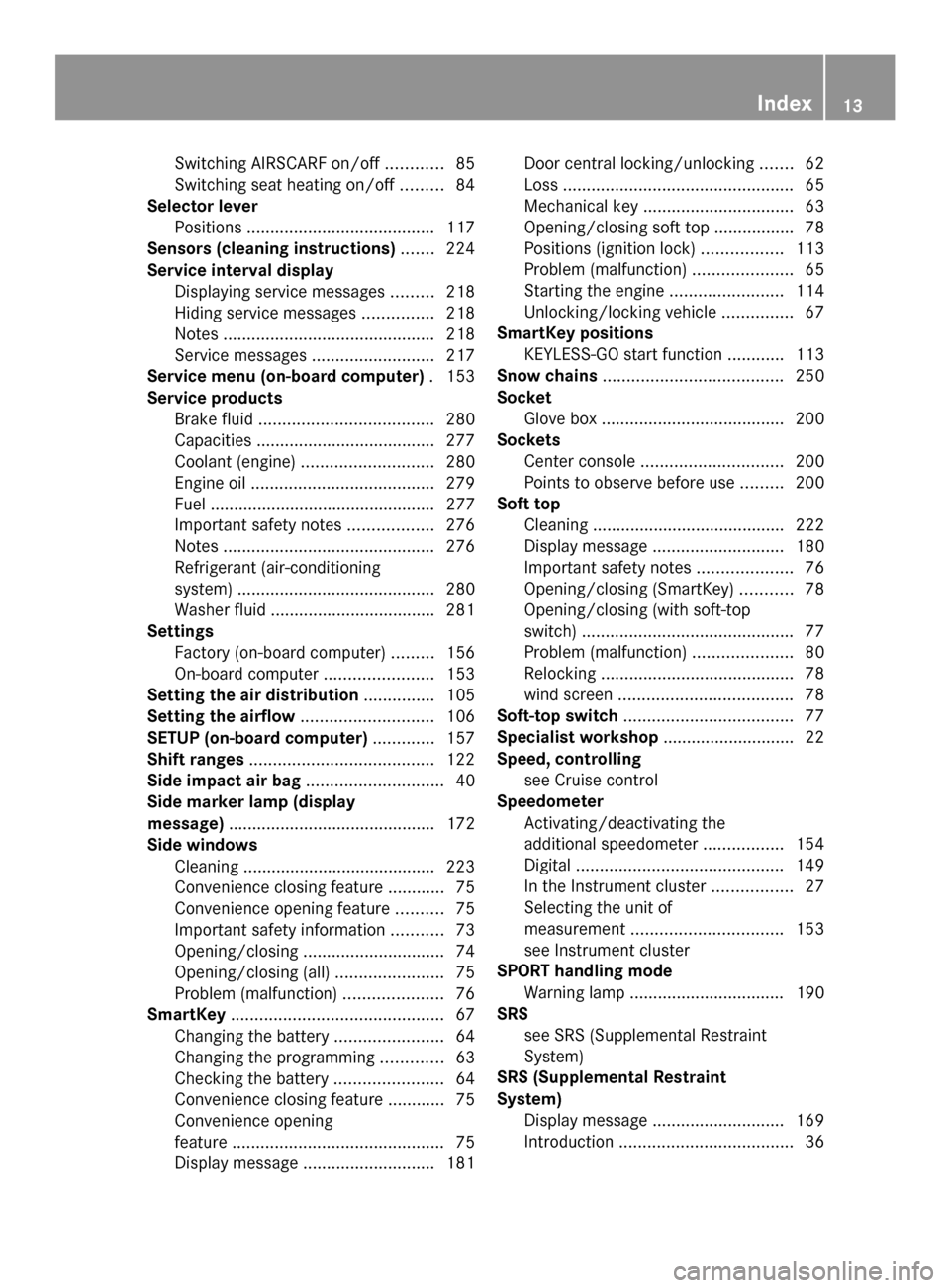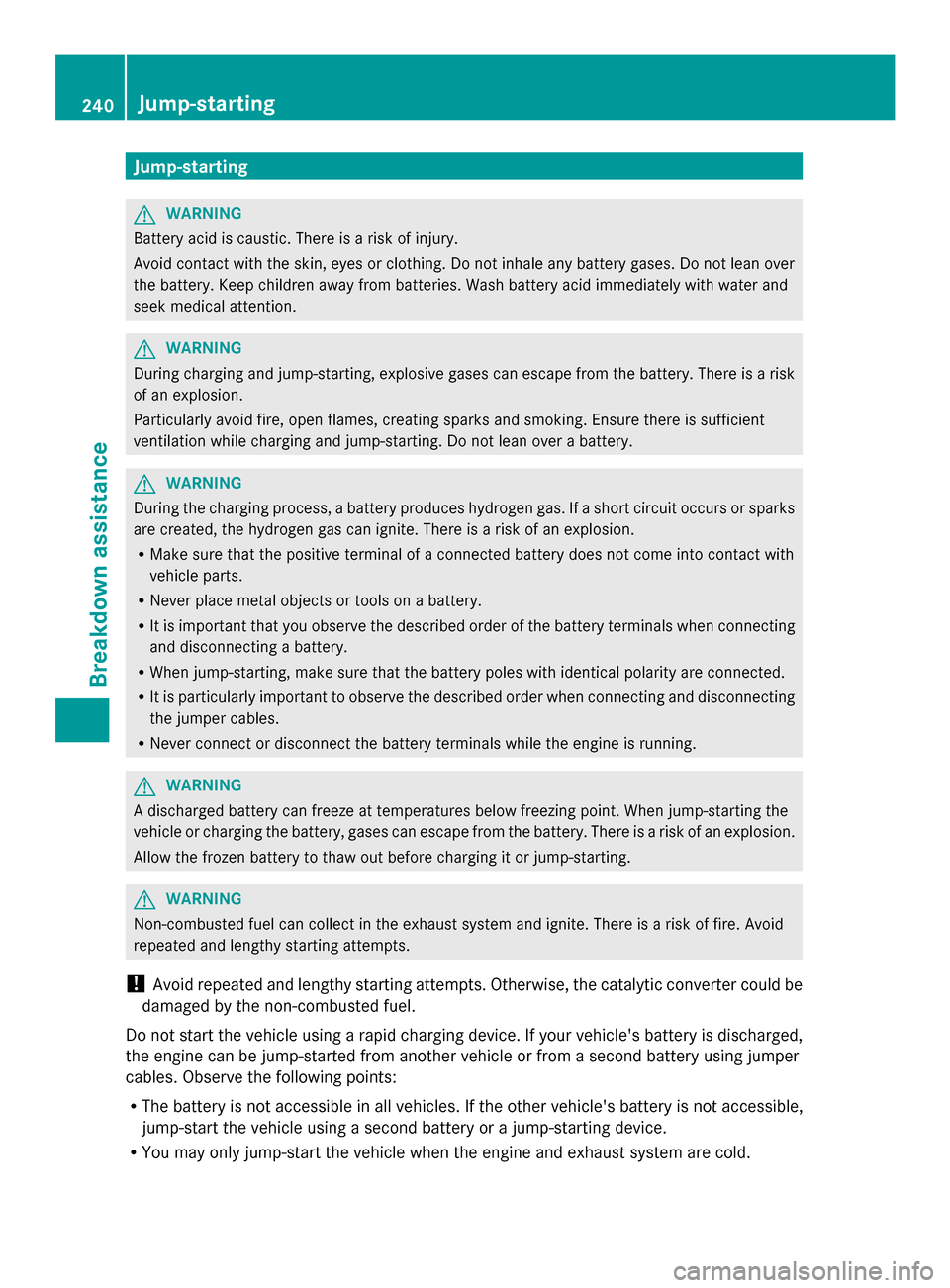2013 MERCEDES-BENZ SLS AMG COUPE fuel cap
[x] Cancel search: fuel capPage 10 of 286

Emergency Tensioning Devices
Function .......................................... .50
Safety guideline s............................. 37
Emissions control
Service and warranty information ....19
Engine
Display message ............................ 172
Engine number ............................... 276
Irregular running ............................ 116
Starting .......................................... 114
Starting problems ..........................116
Starting the engine with the
SmartKey ....................................... 114
Starting with the KEYLESS-GO
start function ................................. 114
Switching off .................................. 128
Engine diagnostics warning lamp ....191
Engine electronics Problem (malfunction) ...................116
Engine oil
Adding ........................................... 216
Additives ........................................ 280
Checking the oil level ..................... 215
Checking the oil level using the
dipstick .......................................... 215
Display
message ................................ 174, 175
Filling capacity ....................... 277, 280
Notes about oil grades ................... 279
Notes on oil level/consumption ....215
Temperature (on-board computer) .157
Temperature gauge ........................ 146
Viscosity ........................................ 280
E-SELECT lever ................................... 117
ESP ®
(Electronic Stability
Program) Deactivating/activating ...................56
Display message ............................ 166
Function/notes ................................ 56
Important safety information ...........56
Warning lamp ................................. 190
ETS (Electronic Traction System) ....... 56
Exhaust check ................................... 131
Exhaust pipe (cleaning
instructions) ...................................... 224Exterior lighting
Setting options ................................ 92
see Lights
Exterior mirrors
Adjusting ......................................... 87
Dipping (automatic) .........................88
Folding in/out (automatically). ........88
Folding in/out (electrically). ............88
Folding in when locking (on-board
computer) ...................................... 156
Out of position (troubleshooting) .....88
Setting ............................................. 88
Storing settings (memory
function) .......................................... 89
Storing the parking position ............. 89 F
Filler cap see Fuel filler flap
First-aid kit ......................................... 228
Flat tire Changing a wheel/mounting the
spare wheel ................................... 232
Preparing the vehicle .....................229
Raising the vehicle .........................233
TIREFIT kit ...................................... 229
Floormat ............................................ .212
Fuel Additives ........................................ 279
Consumption statistics ..................148
Displaying the range ......................149
Driving tips .................................... 130
Fuel gauge ....................................... 27
Grade (gasoline) ............................ 278
Important safety notes ..................277
Problem (malfunction) ...................127
Refueling ........................................ 124
Tank content/reserve fuel .....277, 278
Fuel filler flap, opening/closing ....... 125
Fuel filter (display message) ............176
Fuel level Calling up the range (on-board
computer) ...................................... 149
Fuel tank
Capacity ................................ 277, 278
Problem (malfunction) ...................127
see Fuel tank 8
Index
Page 15 of 286

Switching AIRSCARF on/of
f............ 85
Switching seat heating on/off .........84
Selector lever
Positions ........................................ 117
Sensors (cleaning instructions) .......224
Service interval display Displaying service messages .........218
Hiding service messages ...............218
Notes ............................................. 218
Service messages ..........................217
Service menu (on-board computer) .153
Service products Brake fluid ..................................... 280
Capacities ...................................... 277
Coolant (engine) ............................ 280
Engine oil ....................................... 279
Fuel ................................................ 277
Important safety notes ..................276
Notes ............................................. 276
Refrigerant (air-conditioning
system) .......................................... 280
Washer fluid .................................. .281
Settings
Factory (on-board computer) .........156
On-board computer .......................153
Setting the air distribution ...............105
Setting the airflow ............................106
SETUP (on-board computer) .............157
Shift ranges ....................................... 122
Side impact air bag .............................40
Side marker lamp (display
message) ............................................ 172
Side windows Cleaning ......................................... 223
Convenience closing feature ............75
Convenience opening feature ..........75
Important safety information ...........73
Opening/closing .............................. 74
Opening/closing (all) .......................75
Problem (malfunction) .....................76
SmartKey ............................................. 67
Changing the battery .......................64
Changing the programming .............63
Checking the battery .......................64
Convenience closing feature ............75
Convenience opening
feature ............................................. 75
Display message ............................ 181Door central locking/unlocking
.......62
Loss ................................................. 65
Mechanical key ................................ 63
Opening/closing soft top .................78
Positions (ignition lock) .................113
Problem (malfunction) .....................65
Starting the engine ........................114
Unlocking/locking vehicle ...............67
SmartKey positions
KEYLESS-GO start function ............113
Snow chains ...................................... 250
Socket Glove box ...................................... .200
Sockets
Center console .............................. 200
Points to observe before use .........200
Soft top
Cleaning ......................................... 222
Display message ............................ 180
Important safety notes ....................76
Opening/closing (SmartKey) ...........78
Opening/closing (with soft-top
switch) ............................................. 77
Problem (malfunction) .....................80
Relocking ......................................... 78
wind screen ..................................... 78
Soft-top switch .................................... 77
Specialist workshop ............................ 22
Speed, controlling see Cruise control
Speedometer
Activating/deactivating the
additional speedometer .................154
Digital ............................................ 149
In the Instrument cluster .................27
Selecting the unit of
measurement ................................ 153
see Instrument cluster
SPORT handling mode
Warning lamp ................................. 190
SRS
see SRS (Supplemental Restraint
System)
SRS (Supplemental Restraint
System)
Display message ............................ 169
Introduction ..................................... 36 Index
13
Page 127 of 286

clean water. Seek medical assistance
without delay.
R If fuel is swallowed, seek medical
assistance without delay. Do not induce
vomiting.
R Immediately change out of clothing which
has come into contact with fuel. G
WARNING
Electrostatic buildup can create sparks and
ignite fuel vapors. There is a risk of fire and
explosion.
Touch the vehicle body immediately before
opening the fuel filler cap. Any existing
electrostatic buildup is thereby discharged.
! Do not use diesel to refuel vehicles with a
gasoline engine. Do not switch on the
ignition if you accidentally refuel with the
wrong fuel. Otherwise, the fuel will enter
the fuel system. Even small amounts of the
wrong fuel could result in damage to the
fuel system and the engine. The repair
costs are high. Notify a qualified specialist
workshop and have the fuel tank and fuel
lines drained completely.
! Overfilling the fuel tank could damage the
fuel system.
! Take care not to spill any fuel on painted
surfaces. You could otherwise damage the
paintwork.
! Use a filter when refueling from a fuel can.
Otherwise, the fuel lines and/or injection
system could be blocked by particles from
the fuel can.
If you overfill the fuel tank, fuel could spray
out when the fuel pump nozzle is removed.
Further information on fuel and on fuel grades
can be found in the "Fuel" section
(Y page 277). Refueling
Fuel filler flap When you open or close the vehicle with the
SmartKey, the fuel filler flap is automatically
unlocked or locked.
The fuel filler flap is located to the rear on the
right. The position of the fuel filler cap is
displayed in the instrument cluster
00B6. The
arrow next to the filling pump indicates the
side of the vehicle. 0043
To open the fuel filler flap
0044 Tire pressure table
0087 Fuel type
0085 To insert the fuel filler cap
Opening X
Switch off the engine.
i When the engine is running and the fuel
filler flap is open, the engine diagnostics
warning lamp 00B9may light up.
Further information can be found in the
"Warning and indicator lamps in the
instrument cluster" chapter ( Ypage 191).
X Open the driver's door. This switches the
ignition to position 0, which corresponds to
having removed the SmartKey. The driver’s
door can be closed again.
X Press the fuel filler flap in the direction of
arrow 0043.
The fuel filler flap opens slightly.
X Open the fuel filler flap. Refueling
125Driving and parking Z
Page 128 of 286

X
Turn the fuel filler cap counter-clockwise
and remove it.
X Insert the fuel filler cap into the holder
bracket on the inside of filler flap 0085.
X Completely insert the fuel pump nozzle into
the filler neck and refuel.
X Only fill the tank until the pump nozzle
switches off.
! Overfilling the fuel tank could damage the
fuel system.
Closing X
Replace the fuel filler cap and turn it
clockwise. The fuel filler cap audibly
engages.
X Close the fuel filler flap. 126
RefuelingDriving and parking
Page 178 of 286

Display messages Possible causes/consequences and
0050
0050Solutions 00B6
Gas Cap Loose Gas Cap Loose The fuel system pressure is too low. The fuel filler cap is not closed
correctly or the fuel system is leaking.
X
Check that the fuel filler cap is correctly closed.
If the fuel filler cap is not correctly closed:
X Close the fuel filler cap.
If the fuel filler cap is correctly closed:
X Visit a qualified specialist workshop. 009E
Replace Air Filter Replace Air Filter The air filter is dirty and must be replaced.
X
Visit a qualified specialist workshop. 003A
Check Fuel Filter Check Fuel Filter Vehicles with a diesel engine: there is water in the fuel filter. The
water must be drained off.
X
Visit a qualified specialist workshop. Driving systems
Display messages Possible causes/consequences and
0050 0050Solutions Cruise Control
Cruise Control
Inoperative Inoperative Cruise control is defective.
A warning tone also sounds.
X
Visit a qualified specialist workshop. Cruise Control Cruise Control
--- mph --- mph A condition for activating cruise control has not been fulfilled.
You attempted to save a speed of less than 20 mph
(30 km/h).
X Activate ESP ®
(Y page 56).
X If the situation allows, drive faster than 20 mph (30 km/h) and
save the speed.
X Check the activation conditions for cruise control
(Y page 134). 176
Displays and operationOn-board computer and displays
Page 194 of 286

Problem Possible causes/consequences and
0050
0050Solutions 00E4
The red engine
oil temperature
warning lamp
comes on while
the engine is
running. The
engine oil
temperature is
not displayed. The engine control unit data transfer is malfunctioning.
X
Visit a qualified specialist workshop. 00B5
The yellow
reserve fuel
warning lamp
lights up while
the engine is
running. The fuel level has dropped into the reserve range.
X
Refuel at the nearest gas station. 00B5
The yellow
reserve fuel
warning lamp
flashes while the
engine is
running. The fuel system pressure is too low. The fuel filler cap is not closed
correctly or the fuel system is leaking.
X
Check that the fuel filler cap is correctly closed.
X If the fuel filler cap is not correctly closed: close the fuel filler
cap.
X If the fuel filler cap is closed: visit a qualified specialist
workshop. G
WARNING
Driving when your engine is overheated can cause some fluids which may have leaked into the
engine compartment to catch fire. You could be seriously burned.
Steam from an overheated engine can cause serious burns which can occur just by opening the
engine hood. Stay away from the engine if you see or hear steam coming from it.
Stop the vehicle in a safe location away from other traffic. Turn off the engine, get out of the
vehicle and do not stand near the vehicle until the engine has cooled down.
! If the coolant temperature exceeds 248 ‡(120 †) do not continue driving. The engine will
otherwise be damaged. 192
Displays and operationOn-board computer and displays
Page 242 of 286

Jump-starting
G
WARNING
Battery acid is caustic. There is a risk of injury.
Avoid contact with the skin, eyes or clothing. Do not inhale any battery gases. Do not lean over
the battery. Keep children away from batteries. Wash battery acid immediately with water and
seek medical attention. G
WARNING
During charging and jump-starting, explosive gases can escape from the battery. There is a risk
of an explosion.
Particularly avoid fire, open flames, creating sparks and smoking. Ensure there is sufficient
ventilation while charging and jump-starting. Do not lean over a battery. G
WARNING
During the charging process, a battery produces hydrogen gas. If a short circuit occurs or sparks
are created, the hydrogen gas can ignite. There is a risk of an explosion.
R Make sure that the positive terminal of a connected battery does not come into contact with
vehicle parts.
R Never place metal objects or tools on a battery.
R It is important that you observe the described order of the battery terminals when connecting
and disconnecting a battery.
R When jump-starting, make sure that the battery poles with identical polarity are connected.
R It is particularly important to observe the described order when connecting and disconnecting
the jumper cables.
R Never connect or disconnect the battery terminals while the engine is running. G
WARNING
A discharged battery can freeze at temperatures below freezing point. When jump-starting the
vehicle or charging the battery, gases can escape from the battery. There is a risk of an explosion.
Allow the frozen battery to thaw out before charging it or jump-starting. G
WARNING
Non-combusted fuel can collect in the exhaust system and ignite. There is a risk of fire. Avoid
repeated and lengthy starting attempts.
! Avoid repeated and lengthy starting attempts. Otherwise, the catalytic converter could be
damaged by the non-combusted fuel.
Do not start the vehicle using a rapid charging device. If your vehicle's battery is discharged,
the engine can be jump-started from another vehicle or from a second battery using jumper
cables. Observe the following points:
R The battery is not accessible in all vehicles. If the other vehicle's battery is not accessible,
jump-start the vehicle using a second battery or a jump-starting device.
R You may only jump-start the vehicle when the engine and exhaust system are cold. 240
Jump-startingBreakdown assistance
Page 254 of 286

To test tire pressure, use a suitable pressure
gauge. The outer appearance of a tire does
not permit any reliable conclusion about the
tire pressure. On vehicles equipped with the
electronic tire pressure monitor, the tire
pressure can be checked in the on-board
computer. G
WARNING
Should the tire pressure drop repeatedly:
R check the tire for foreign bodies.
R check whether the wheel is losing air or the
valve is leaking.
R make sure that only a valve cap approved
by Mercedes-Benz is installed on the tire
valve.
Tire pressures that are too low have a
negative effect on vehicle safety, which could
lead you to cause an accident.
Only correct tire pressures when the tires are
cold. The tires are cold when the vehicle has
been parked for at least three hours or driven
for less than 1 mile (1.6 km). The tire
temperature changes depending on the
outside temperature, the vehicle speed and
the tire load. If the tire temperature changes
by 18 ‡(10 †), the tire pressure changes by
approximately 10 kPa (0.1 bar/1.5 psi). Take
this into account when checking the pressure
of warm tires and only correct the tire
pressure if it is too low for the current
operating conditions. If you check the tire
pressure when the tires are warm, the
resulting value will be higher than if the tires
were cold. This is normal. Do not reduce the
tire pressure to the value specified for cold
tires. The tire pressure would otherwise be
too low.
Observe the recommended tire pressure
specifications for cold tires on the Tire and
Loading Information placard on the B-pillaron
the driver's side.
i The specifications given on the following
Tire and Loading Information placard are
examples. Tire pressure specifications are
vehicle-specific and may deviate from the data shown here. The tire pressures
applicable to your vehicle can be found on
the Tire and Loading Information placard on
your vehicle.
The Tire and Loading Information placard
shows recommended tire pressure
specifications
0043for cold tires when the
vehicle is fully laden. The tire pressure
specifications apply to tires which are
mounted at the factory. Important notes on tire pressure
G
WARNING
If the tire pressure drops repeatedly, check
the tires for punctures from foreign objects
and/or whether air is leaking from the valves
or from around the rim.
The tire temperature and pressure increase
when the vehicle is in motion. This is
dependent on the driving speed and the load.
If you wish to drive at high speeds of
100 mph (160 km/h )or higher when this is
allowed, use the tire pressure table on the
inside of the fuel filler flap to set the correct
tire pressures when the wheels are cold. If the
tire pressure is not set correctly, this can lead
to an excessive build-up of heat and a sudden
loss of pressure.
For more information, contact a qualified
specialist workshop.
i Driving comfort can be impaired if the tire
pressure value recommended in the tire 252
Tire pressureWheels and tires